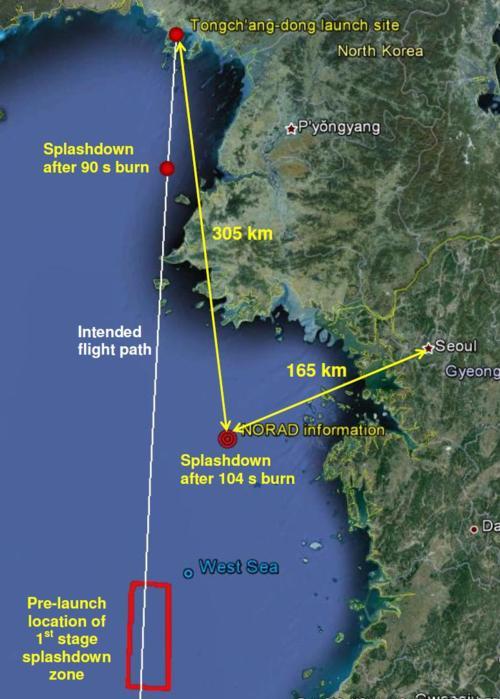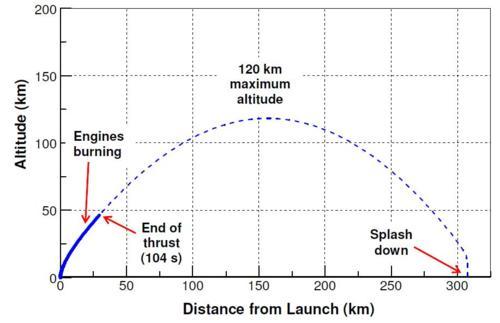 Figure 1.
Figure 1.
It’s still not clear how accurate the reports are about yesterday’s launch failure, but some of the information seems to fit together, as I describe here.
Some of the numbers from reports are that:
- The rocket engines burned for less than two minutes before the failure
- The rocket body broke into pieces and the pieces continued traveling through the atmosphere for 6 to 7 minutes
- The pieces reached a maximum altitude of 120 km
- The pieces splashed down in the Yellow Sea 165 km southwest of Seoul.
To look at the situation, I used the computer model of the Unha-3 that I discussed in an earlier post and looked at the trajectory of the rocket body assuming that the engines operated for different lengths of time before the failure. The dot labeled “90 s burn” in Figure 1 shows where the debris would have fallen if the failure occurred 90 seconds after launch and the launcher flew on its intended trajectory. This seems to rule out reports of shorter failure times.
What I find is that if the first stage engine burned for 104 seconds before the failure, the debris would splash down 305 km from the launch site as shown in Figure 1. That location is consistent with being 165 km southwest of Seoul. (That point is labeled “NORAD information” since it first appeared in U.S. reports yesterday.)
Moreover, Figure 2 shows that under this scenario the rocket body would reach a maximum altitude of 120 km. And the time I calculate from the end of thrust to splashdown of the debris is about 7.5 minutes, which is roughly consistent with press reports.
 Figure 2.
Figure 2.
Since the first stage is thought to burn for about two minutes, this strongly suggests the failure happened before the second stage ignited.
In North Korea’s 2006 satellite launch attempt, the rocket failed at about 40 seconds after launch. That failure may have been due to a buckling of the rocket due to atmospheric forces. Those forces on the rocket increase as the speed of the launcher increases and can be very strong at low altitudes where atmospheric density is highest (the forces are proportional to the atmospheric density times the square of the rocket’s speed). As the rocket gets higher, the speed increases but the atmospheric density decreases so those forces fall off. For the Unha, those forces are greatest about 60 seconds into flight, when the launcher is at an altitude of about 12 km. So at 40 seconds those forces are starting to increase rapidly, which may have caused the problems.
However, by 104 seconds, those atmospheric forces are down to about 5% of their maximum value, so it is not clear this failure was related to these forces. At that point the rocket was at an altitude of just under 50 km.
The breakup of the rocket may have been due to an explosion, either unintentional or due to a command from ground control if it determined that the rocket was malfunctioning or going off course. The breakup may also have occurred if the rocket body began to rotate after the engine failed, since the lack of power would have removed North Korea’s ability to control and stabilize it. As the body turned sideways, the atmospheric forces acting across the 30 meter length of the rocket could cause it to snap into pieces.
As I noted in an earlier post, if the splashdown point of the rocket body was really well off the intended trajectory as the distance from Seoul implies, that may indicate that the launcher was beginning to veer off course and the engines were shut down by ground control.
Previous post on North Korea.
